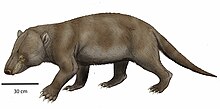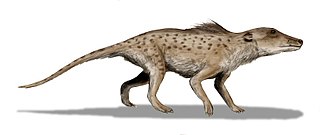
Pakicetidae is an extinct family of Archaeoceti that lived during the Early Eocene in Pakistan.

Uintatherium is an extinct genus of herbivorous dinoceratan mammal that lived during the Eocene epoch. Two species are currently recognized: U. anceps from the United States during the Early to Middle Eocene and U. insperatus of Middle to Late Eocene China.
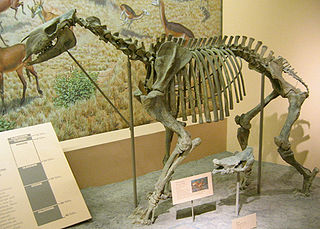
Chalicotheriidae is an extinct family of herbivorous, odd-toed ungulate (perissodactyl) mammals that lived in North America, Eurasia, and Africa from the Middle Eocene until the Early Pleistocene, existing from 48.6 to 1.806 mya. They are often called chalicotheres, a term which is also applied to the broader grouping of Chalicotherioidea. They are noted for their unusual morphology compared to other ungulates, such as their elongated clawed forelimbs. They are thought to have been browsers.

Miacis is an extinct genus of placental mammals from clade Carnivoraformes, that lived in North America from the early to middle Eocene.

Metacheiromys is an extinct genus of placental mammals from extinct paraphyletic subfamily Metacheiromyinae within extinct paraphyletic family Metacheiromyidae in extinct order Palaeanodonta, that lived in North America from the early to middle Eocene.
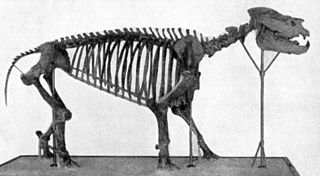
Metamynodon is an extinct genus of amynodont that lived in North America and Asia from the late Eocene until early Oligocene, although the questionable inclusion of M. mckinneyi could extend their range to the Middle Eocene. The various species were large, displaying a suit of semiaquatic adaptations more similar to those of the modern hippopotamus, despite their closer affinities with rhinoceroses.

Oxyaena is an extinct genus of placental mammals from extinct subfamily Oxyaeninae within extinct family Oxyaenidae, that lived in Europe, Asia and North America during the early Eocene.

Megacerops is an extinct genus of the prehistoric odd-toed ungulate family Brontotheriidae, an extinct group of rhinoceros-like browsers related to horses. It was endemic to North America during the Late Eocene epoch, existing for approximately 4.1 million years.
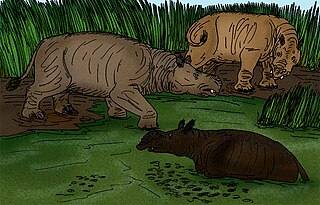
Amynodontidae is a family of extinct perissodactyls related to true rhinoceroses. They are commonly portrayed as semiaquatic hippo-like rhinos but this description only fits members of the Metamynodontini; other groups of amynodonts like the cadurcodontines had more typical ungulate proportions and convergently evolved a tapir-like proboscis.

Patriofelis is an extinct genus of large, cat-like predatory placental mammals from extinct subfamily Oxyaeninae within extinct family Oxyaenidae, that lived in North America from the early to middle Eocene. It was around 1.2 to 1.8 metres long, not including the tail, and weighed about 40–90 kg, making it around the same size as a modern cougar. It had short legs with broad feet, suggesting that it may have been a poor runner, but a quite good swimmer. As its close relative Oxyaena was a reasonably good climber, it is possible Patriofelis could climb as well. It is found in particular in the Bridger Basin of southwestern Wyoming and at John Day Fossil Beds National Monument, Oregon, both in the United States.
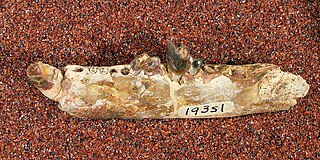
Uintacyon is an extinct paraphyletic genus of placental mammals from clade Carnivoraformes, that lived in North America from the early to middle Eocene.

Didymictis is an extinct genus of placental mammals from extinct subfamily Didymictinae within extinct family Viverravidae, that lived in North America and Europe from the late Paleocene to middle Eocene.

Tillodontia is an extinct suborder of eutherian mammals known from the Early Paleocene to Late Eocene of China, the Late Paleocene to Middle Eocene of North America where they display their maximum species diversity, the Middle Eocene of Pakistan, and the Early Eocene of Europe. Leaving no descendants, they are most closely related to the pantodonts, another extinct group. The tillodonts were medium- to large-sized animals that probably feed on roots and tubers in temperate to subtropical habitats.
Brachyhyops is an extinct genus of entelodont artiodactyl mammal that lived during the Eocene Epoch of western North America and southeastern Asia. The first fossil remains of Brachyhyops are recorded from the late Eocene deposits of Beaver Divide in central Wyoming and discovered by paleontology crews from the Carnegie Museum of Natural History during the early 20th century. The type species, Brachyhyops wyomingensis, is based on a single skull and was named by E.H. Colbert in 1937, but was not officially described until 1938. During the latter half of the 20th century, additional specimens from North America have been recorded from Saskatchewan and as far south as Texas, indicating that Brachyhyops had a broad distribution and was well-dispersed throughout western North America.

Sinopa is an extinct genus of placental mammals from extinct family Sinopidae within extinct order Hyaenodonta, that lived in North America and Asia from the early to middle Eocene.

Limnocyon is an extinct paraphyletic genus of limnocyonid hyaenodonts that lived in North America during the middle Eocene. Fossils of this animal have been found in California, Utah and Wyoming.
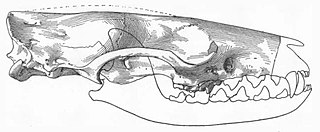
Viverravus is an extinct genus of placental mammals from extinct subfamily Viverravinae within extinct family Viverravidae, that lived in North America, Europe and Asia from the middle Paleocene to middle Eocene.
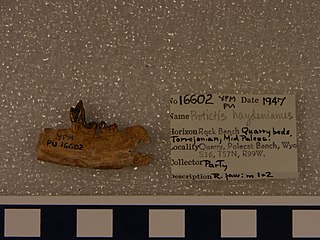
Protictis is an extinct paraphyletic genus of placental mammals from extinct subfamily Didymictinae within extinct family Viverravidae, that lived in North America from early Paleocene to middle Eocene.

Hemipsalodon is an extinct genus of hyainailourid hyaenodonts from the subfamily Hyainailourinae that lived in North America during the middle to late Eocene.

Xenocranium is an extinct monotypic genus of placental mammal from extinct paraphyletic subfamily Epoicotheriinae within extinct paraphyletic family Epoicotheriidae in extinct order Palaeanodonta, that lived in North America during the late Eocene.

